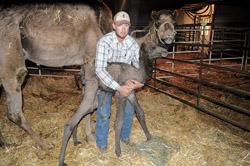 How long does it take to milk a camel? About 90 seconds, says Kyle Hendrix. That’s the amount of time it takes the camel to devour a pound of grain and chomp down the hay Hendrix bribes her with. After that she holds her milk back, and Hendrix disconnects the milk machine. He then lets the camel’s calf – which “primed” the camel before milking – finish the job. Why would anyone want to milk a camel?
How long does it take to milk a camel? About 90 seconds, says Kyle Hendrix. That’s the amount of time it takes the camel to devour a pound of grain and chomp down the hay Hendrix bribes her with. After that she holds her milk back, and Hendrix disconnects the milk machine. He then lets the camel’s calf – which “primed” the camel before milking – finish the job. Why would anyone want to milk a camel?
Opportunity, says Hendrix, a 27-year-old beginning farmer, who found it financially impossible to operate a traditional cattle dairy with high feed and rent costs in 2010-2011. On a trip to attend a dairy show he stopped at Passow’s Camel Farm in Perry, Okla., and visited with camel breeder Ralph Passow.
With only 3,000 camels in the U.S. and growing demand from immigrants for the milk, Hendrix decided to plunge into the niche market; in addition to managing his father’s 600-head beef cow herd and feedlot.
Hendrix currently has three cow/calf camel pairs and a bull.
“A lot of people thought we were crazy. It’s something different and unique, but I think the market will take off,” he says.
While he was the first to start a camel dairy in Colorado, there are other camel dairies run by the Amish in Michigan, Pennsylvania and Missouri as well as a couple of dairies in California and Oklahoma.
Some people who can’t tolerate cow’s milk can drink camel’s milk because of its lower lactose content. It’s low fat, low-protein and tastes like cow’s milk, only a little sweeter, Hendrix says. Health-wise, many consider just small amounts to be helpful for diabetics because of its high insulin content. Others claim its high level of nutrients and antibodies improve autism symptoms and help fight cancer and a variety of other health problems. Hendrix’s camels give him 1 1/2 to 2 gal. of milk each day (in two milkings with typical dairy cow milking equipment).
Currently he sells shares (whole, half and quarter increments) for raw milk to customers in Colorado. One share is worth 4 gal. a month. Any milk not sold is used by his wife, Holly, to make soap, which is also known for its healthful properties. Hendrix’s goal is to build a processing plant so he can pasteurize the milk and sell it anywhere in the country.
Developing a camel herd is challenging. The females don’t breed until they are 3 or 4 years old (bulls are 5 or 6). Gestation is 13 months, and a calf must stay with its mother for her to produce milk.
On the positive side, camels live 30 to 40 years.
Camels are easy keepers on brome grass hay and eat noxious weeds and cactus. By law, Hendrix fences them in with a 6-ft. perimeter fence and a second fence.
“The biggest thing is they have to be wormed every two months,” he says. “But they’re easy going. You just have to treat them nice. They have a good memory. It takes me about 4 days to break them in to get them in the stall to milk them,” he says.
1-800-834-9665
He Milks Camels In Colorado
FARM SHOW Magazine » He Milks Camels In Colorado
He Milks Camels In Colorado
